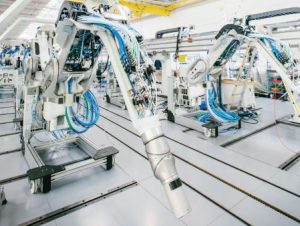 Advanced robotics call for advanced cables from Lapp
Advanced robotics call for advanced cables from Lapp
April 27, 2016 REDWIRE is news you can use from leading suppliers. Powered by FRASERS.
Posted by Lapp Canada Inc
Lapp Canada designs and manufactures durable and reliable electrical connectivity solutions that ensure maximum uptime f... Read more
Subscribe
Free REDWIRE e-newsletter

The continual advancements in robotic technology demand components like cables and connectors that can keep up with the changes. These components are essential to robotic systems.
A whitepaper entitled “The next generation of advanced robotics”, written by Lapp Group product manager Lucas Kehl, highlights trends in advanced robotics, outlines how Lapp is keeping up with them, and provides advice on proper cable selection.
Current trends in robotics
Today's robots are continually becoming smaller, lighter and more nimble. These changes are related to another trend: increased mobility. As a result, cables for robotic systems must also become lighter and more compact.
Lapp is working to meet this requirement with new technologies, such as foamed materials and thin jackets. Despite the lighter, thinner plastic jacketing, these cables offer the same power capacity, with no loss in performance. A variety of materials may be used in the cable construction for weight savings, including specialized plastics, copper-coated aluminum, and various aluminum alloys.
Another way cable manufacturers are addressing lightweight and space-saving requirements is with hybrid cables that combine several functions into one component. For instance, Lapp offers a range of hybrid cables that can handle both data and power transmission.
However, the whitepaper points out that the increased mobility of robots calls for more than just lightweight and space-saving components. Cables must also be durable enough to withstand millions of bending and twisting cycles. To meet this requirement, Lapp offers wear-resistant cables designed for simultaneous flexing and torsion loads. For example, the OLFLEX Robot F1 is a TPE-PUR robot cable that is ideal for multi-axis articulated robots and automated handling equipment.
Choosing the right cable
There are a number of factors to consider when specifying and installing cables for an advanced robotic system. They include the type of motion involved and the bend radius requirements. For example, most robotic systems involve fast and repetitive motions, which call for high-flex cables. If the wrong type of cable is used or it is installed incorrectly, the result can be premature wear and failure.
A good place to start is by consulting a knowledgeable cable manufacturer or systems integrator. Contact Lapp Canada for more information.
Share
Posted by Lapp Canada Inc
Lapp Canada designs and manufactures durable and reliable electrical connectivity solutions that ensure maximum uptime f... Read more